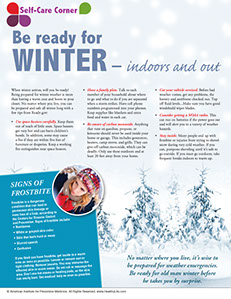SYMPTOM CHECKER
CONDITIONS
Male
Female
Child
Arm, Hand & Shoulder Concerns
Legs & Feet Concerns
Dental & Mouth Concerns
Ear & Nose
Eye Conditions
Head Conditions
Arm, Hand & Shoulder Concerns
Legs & Feet Concerns
Front
Back
Arm, Hand & Shoulder Concerns
Dental & Mouth Concerns
Ear & Nose
Eye Conditions
Head Conditions
Arm, Hand & Shoulder Concerns
Dental & Mouth Concerns
Ear & Nose
Eye Conditions
Head Conditions
Front
Back
Arm, Hand & Shoulder Concerns
Neck Links
Head & Neck Concerns
Arm, Hand & Shoulder Concerns
Neck Links
Head & Neck Concerns
Front
Back
Online Clinic
Wise Healthcare
Be ready for winter – indoors and out
Print on Demand
When winter arrives, will you be ready? Being prepared for winter weather is more than having a warm coat and boots in your closet. No matter where you live, you can be prepared and safe all winter long with a few tips from Ready.gov:
• Use space heaters carefully. Keep them out of reach of little ones. Space heaters get very hot and can burn children’s hands. In addition, some may cause a fire if they are within five feet of furniture or draperies. Keep a working fire extinguisher near space heaters.
• Have a family plan. Talk to each member of your household about where to go and what to do if you are separated when a storm strikes. Have cell phone numbers programmed into your phones. Keep supplies like blankets and extra food and water in each car.
• Be aware of carbon monoxide. Anything that runs on gasoline, propane, or kerosene should never be used inside your home or garage. This includes generators, heaters, camp stoves, and grills. They can give off carbon monoxide, which can be deadly. Only use these outdoors and at least 20 feet away from your home.
• Get your vehicle serviced. Before bad weather comes, get any problems, the battery and antifreeze checked out. Top off fluid levels...Make sure you have good windshield wiper blades.
• Consider getting a NOAA radio. This can run on batteries if the power goes out and will alert you to a variety of weather hazards.
• Stay inside. Many people end up with frostbite or injuries from trying to shovel snow during very cold weather. If you can, postpone shoveling until it’s safe to go outside. If you must go outdoors, take frequent breaks indoors to warm up.
Signs of frostbite
Frostbite is a dangerous condition that can lead to permanent skin damage or even loss of a limb, according to the Centers for Disease Control and Prevention. Signs of frostbite include:
• Numbness
• White or grayish skin color
• Skin that feels hard or waxy
• Slurred speech
• Confusion
If you think you have frostbite, get inside to a warm area as soon as possible. Loosen or remove wet or tight clothing. Remove jewelry. You may immerse the affected skin in warm water. Do not rub or massage the area. Don’t use hot stoves or heating pads, as the skin can easily burn. Get medical help as soon as possible.
No matter where you live, it’s wise to be prepared for weather emergencies. Be ready for old man winter before he takes you by surprise.
This website is not meant to substitute for expert medical advice or treatment. Follow your doctor’s or health care provider’s advice if it differs from what is given in this guide.
The American Institute for Preventive Medicine (AIPM) is not responsible for the availability or content of external sites, nor does AIPM endorse them. Also, it is the responsibility of the user to examine the copyright and licensing restrictions of external pages and to secure all necessary permission.
The content on this website is proprietary. You may not modify, copy, reproduce, republish, upload, post, transmit, or distribute, in any manner, the material on the website without the written permission of AIPM.
2021 © American Institute for Preventive Medicine - All Rights Reserved. Disclaimer | www.HealthyLife.com















































_web-u573076-fr.jpg?crc=4106038948)

